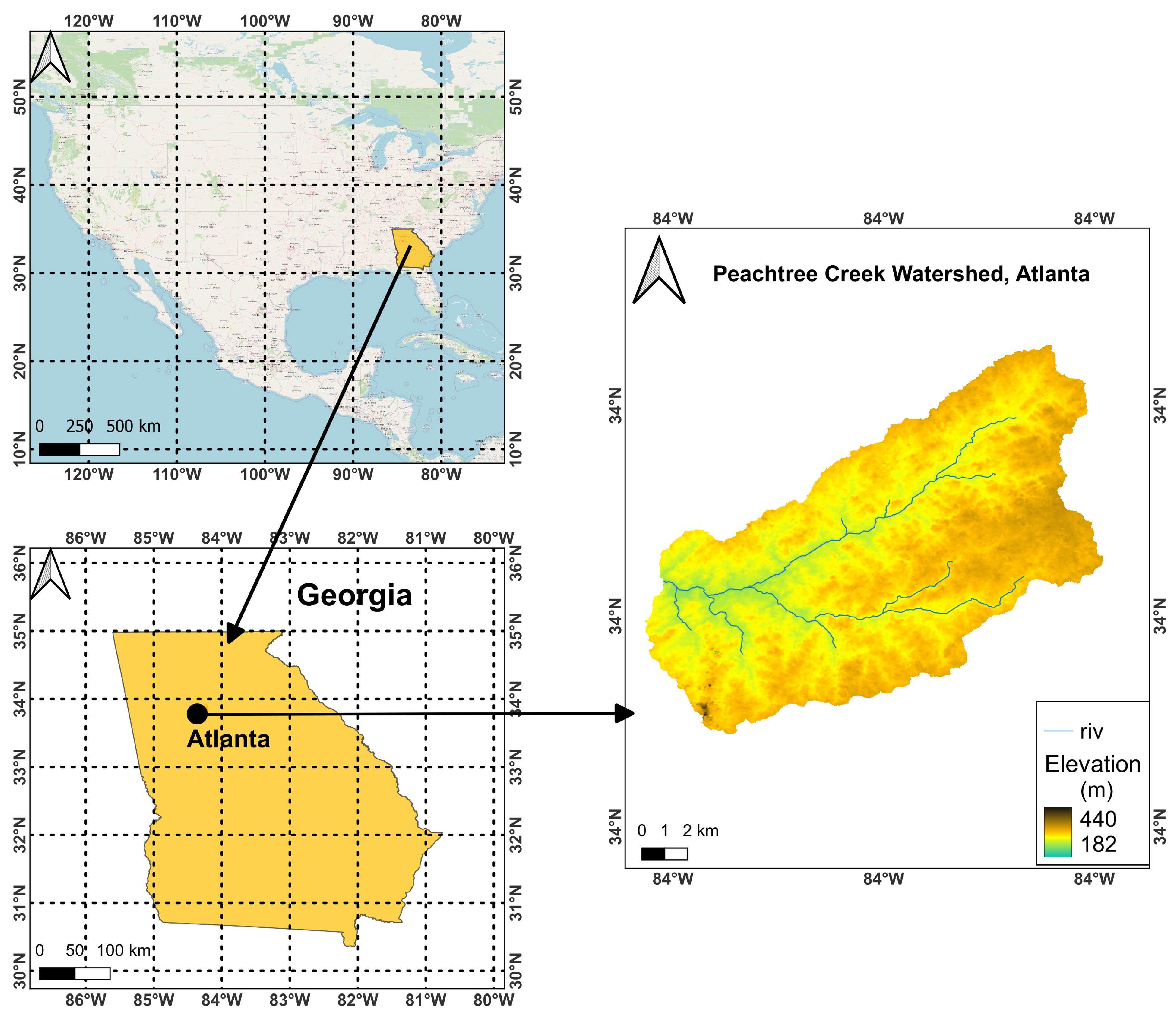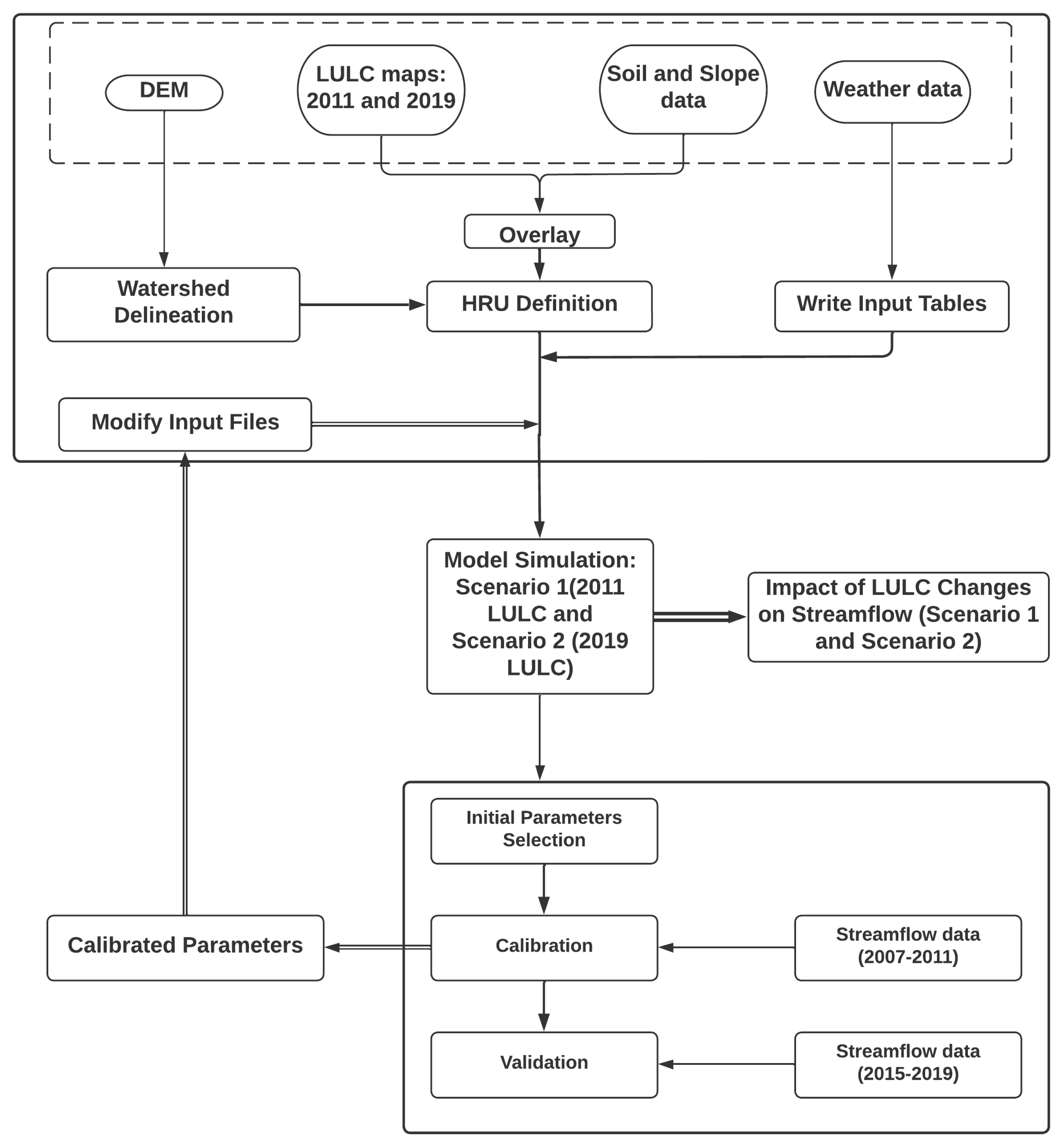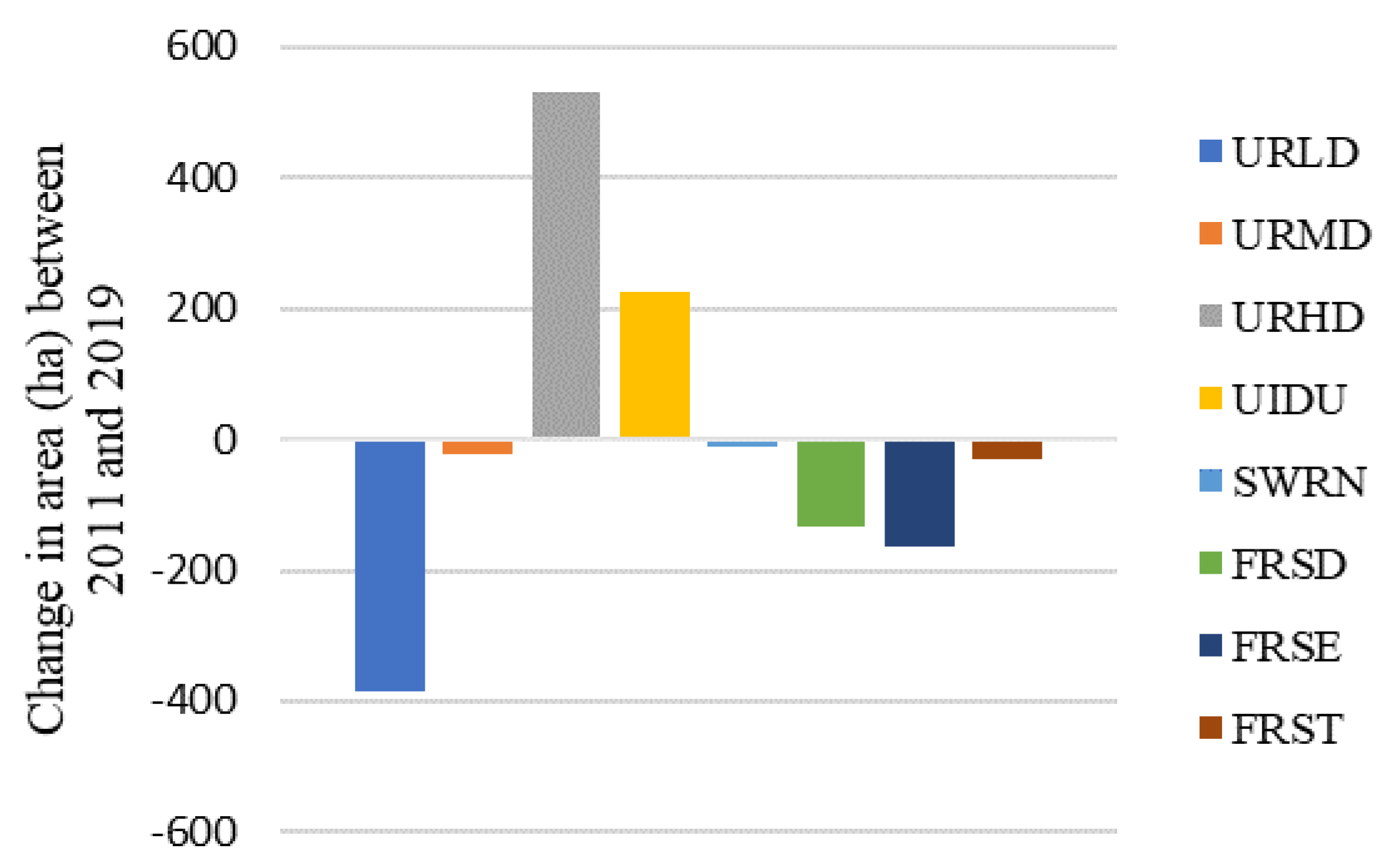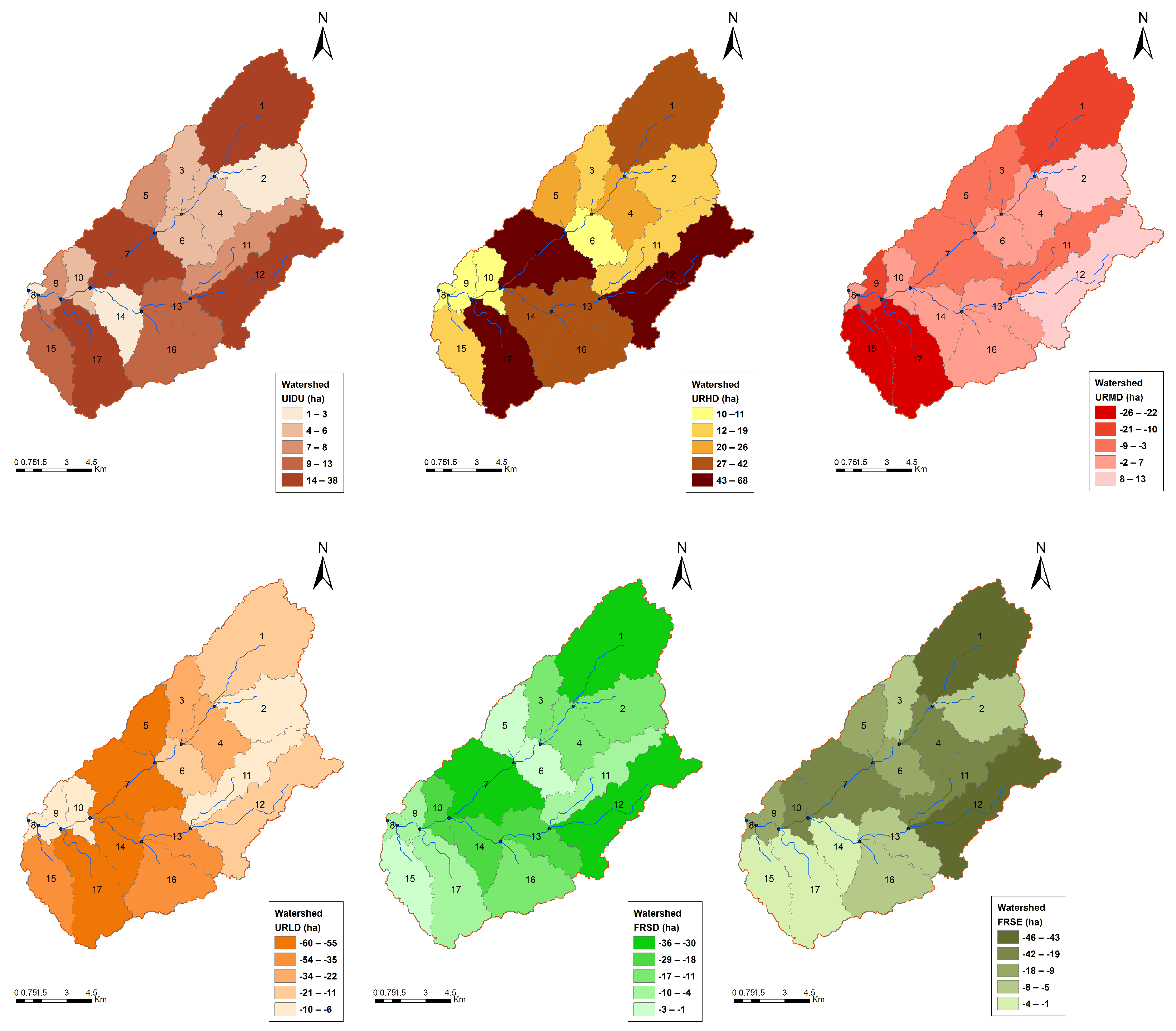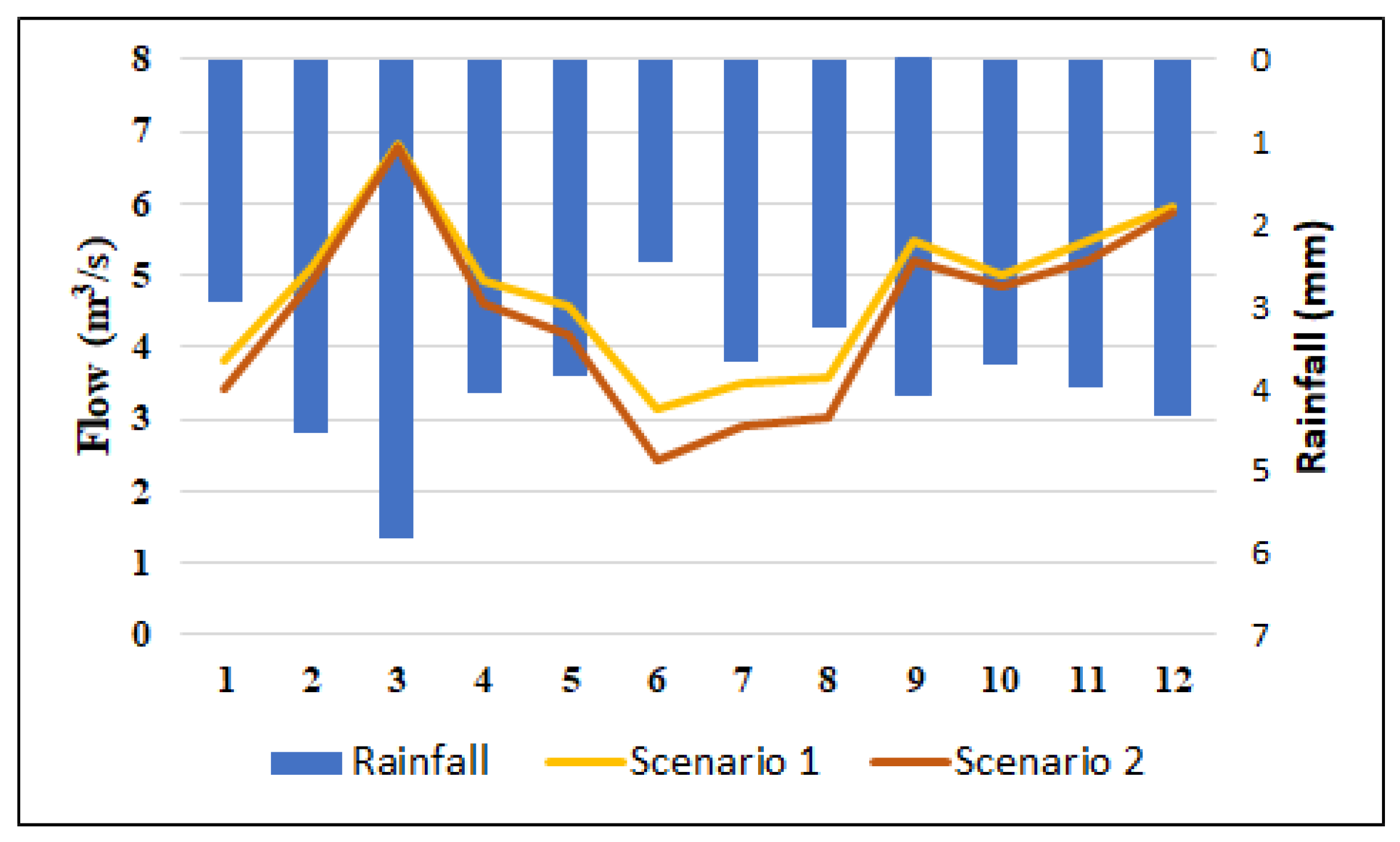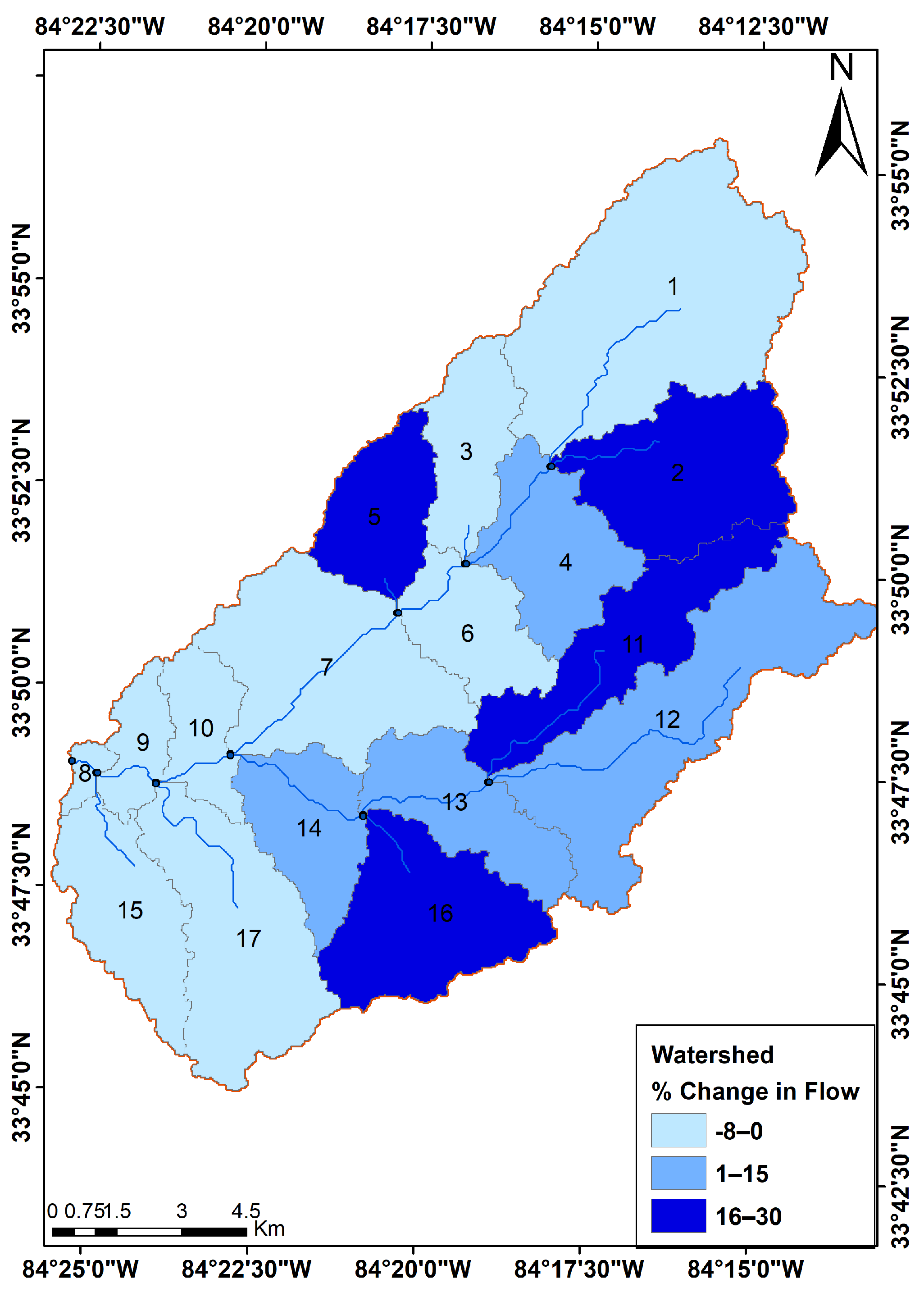1. Introduction
The water-related disasters are associated with a high degree of randomness and uncertainty, triggering substantial socioeconomic and environmental damages. For example, in India, out of all the natural disasters, 40% of deaths are due to floods alone, and between 1980 and 2017, the economic loss from floods accounted for about
$58.7 billion (Emergency Events Database, EM-DAT 2018). Recent years have witnessed a rise in the frequency, magnitude, and intensity of these events, which are direct consequences of meteorological forcings, mostly accelerated by anthropic-induced changes [
1,
2]. Zhang [
2] studied the influence of anthropogenic forces on precipitation trends and suggested an increase in global mean precipitation, changes in the latitudinal pattern of precipitation (i.e., an increase in precipitation in high latitudes and a decrease in sub-tropical latitudes), and a shift in the position of intertropical convergence zone (ITCZ). The changes in land-use patterns, especially in urbanizing watersheds, cause substantial variations in temperature and moisture, which, in turn, alters the hydrological regime of the catchment [
3,
4]. This results in increased high flows (vulnerable to flooding during heavy precipitation events) and reduced low flows (affect water availability as well as water quality) [
5]. In addition, an increase in water demand further affects the low flow conditions. Thus, there is a need to identify the changes in high- and low-flow conditions of the watershed for sustainable management of water resources.
Anthropic-induced land-use/land-cover (LULC) changes create an imbalance between water and energy fluxes, thus affecting rainfall-runoff partitioning by triggering variations in evapotranspiration (ET) rates, groundwater recharge, and soil water. It is observed that an increase in impervious fraction leads to water accumulation in the upper soil depths, thus increasing surface runoff and ET [
3]. Vaibhav [
4] observed an increase in annual surface runoff by approximately 45%, due to an increase in the urban area and a reduction in forest and cropland. Cong [
6] conducted a study to estimate ET in plain, mountainous, urban, and sub-urban areas using the surface energy balance system (SEBS) model. The results indicated that ET rates is highest in urban areas and lowest in mountainous areas. Siddik [
7] observed a reduction in groundwater recharge by 17.1 mm/year, due to an increase in the built-up area and bare soil and a reduction in open water sources, due to meandering. Galiano [
8] indicated that the conversion of agricultural land to built-up areas altered the flood characteristics of the catchment and increased flood peak discharge and volume by 24 and 26%, respectively. Thus, the hydrological response of the watershed is strongly correlated to changes in LULC patterns.
LULC changes in a watershed over the years also show sub-basin scale diversification. Garg [
4] studied the impact of different LULC scenarios on basin water balance components (WBCs). It was observed that the upstream part of the basin showed an increasing trend in all WBCs, whereas the lower part of the basin showed a decreasing trend, indicating spatial variation in hydrological components. Pumo [
3] indicated that rainfall-runoff response could significantly change with spatial scale. The study suggested that, at a larger scale, alterations in both runoff and evapotranspiration were less evident, with imposed changes in LULC. Further, the LULC changes also influence the temporal behavior of WBCs [
9]. Li [
10] observed that, with the expansion of agricultural land, there was a sharp decline in streamflow during the wet season, due to reduced groundwater contribution, whereas a slight increase in streamflow during the dry season was due to a decrease in soil water. Serur [
11] indicated significant variations in the temporal distribution of WBCs and streamflow, with an increase in agriculture land and urban areas. An increase in wet season streamflow (due to higher surface runoff) and a reduction in dry season streamflow were observed (due to reduced baseflow and higher ET). Chen [
12] analyzed the impact of desertification on soil moisture content due to the clearing of vegetation. The study concluded that land-cover changes alter porosity, soil structure matrix, and surface energy, leading to variations in the spatio-temporal distribution of soil water. Therefore, identifying the multi-scale variability in the hydrological response of watersheds helps policymakers in decision-making.
Soil water assessment tool (SWAT), developed by the US Department of Agriculture (USDA), is a physical-based semi-distributed hydrologic model. Several studies have reported the use of SWAT to identify the impact of various management activities on the surface flows, groundwater storage, and also in the simulation of hydro-climatic extremes [
13,
14,
15]. The SWAT model is also adopted to examine the change in hydrological processes in response to LULC alterations. Palamuleni [
16] investigated the role of land cover changes of the Upper Shire River, Malawi, in the degradation of flow regimes using the SWAT model. The study analyzed the trends in land cover change between 1989 and 2002, and the simulations indicated an increase in peak flows and faster time of travel with land cover changes. Zhu [
17] assessed the long-term hydrological impact in the Little River Watershed, Tennessee, using the SWAT model and LULC change from 1984–2010. The model calibrated and validated for the observed streamflow of 2010 and simulated for different LULC change scenarios indicated an increase in streamflow with urban expansion. Munoth [
18] studied the impact of LULC change on runoff and sediment yield in the Upper Tapi River sub-basin, India. The LULC maps corresponding to the years 1975, 1990, 2000, and 2016, with the corresponding climate data, were used to develop four different models and were calibrated separately. The model simulations by changing the LULC maps with their calibrated parameters revealed an increase in runoff, water yield, and sediment yield, with agriculture expansion and loss of forest cover. Mengistu [
19] calibrated the simulation of each reference LULC period (2000, 2010, and 2020) obtained from the SWAT model to understand the implications of LULC changes in Gilgel Gibe, an East African watershed. The study indicated an increase in surface runoff and a decrease in groundwater recharge, with the expansion of agricultural and grasslands and loss of forest. Ref. [
20] used the SWAT model to identify the effect of LULC changes on the natural flow of the Ramganga River Basin, India, for a period of 43 years. The model simulation, with Nash–Sutcliffe efficiency as a performance indicator, gave a good correlation between observed and simulated flows and indicated an increase in the average natural flows.
Despite numerous studies on the implications of LULC changes on watershed hydrology, the following aspects were not given much attention: (i) how variations in model parameters related to soil, evaporation, and groundwater, as a consequence of LULC changes and the influence of spatial and temporal changes in streamflow, and (ii) the interplay of these parameters, the land-use pattern, and the intra-annual variations in climate in the generation of extreme flows. Further, the studies also neglected to examine the nature of hydrological response causing spatio-temporal variations in streamflow and generation of extremes [
3,
4,
7]. Identifying the sub-basin scale change in land-use pattern and streamflow helps in locating water-stressed/excess regions and limiting the development activities. Temporal variations in streamflow help in identifying the flow regime of the basin, analyzing the occurrence of extreme events and developing an optimal framework for the seasonal allocation of water resources. One way of understanding the mechanism involved in spatio-temporal variability of streamflow is through model parameters, as it reflects changes in water balance components (WBCs) in response to LULC alterations. The focus of this paper is to study the effect of anthropic-induced LULC changes on extreme streamflow generation using the soil and water assessment tool (SWAT). The specific objectives are to (i) identify the variations in model parameters and corresponding implications on WBCs in response to LULC changes, (ii) analyze spatial and temporal variability in streamflow, and (ii) quantify the effect on the generation of extreme (high- and low-flow). The study is conducted in the Peachtree Creek watershed, Atlanta, Georgia, having a considerable degree of urbanization.
The paper is organized as follows. The research methodology is outlined in
Section 2.
Section 3 presents the observation obtained by SWAT modeling and discussions on critical results.
Section 4 contains a summary and conclusion, followed by references.
3. Results and Discussion
3.1. LULC Change Analysis
To assess the impact of LULC changes on watershed hydrology and streamflow land-use/land-cover, maps from 2001, 2008, 2011, 2016, and 2019 were studied. The study indicated a significant change in area under urban and other land-use classes between 2011 and 2019. Hence, the LULC datasets of 2011 and 2019 were used to build two models of the watershed. The analysis showed significant changes in the area under the low-density urban residential areas (URLD), high-density urban residential areas (URHD), and urban industrial areas (UIDU), as shown in
Figure 3. The areas under URHD and UIDU increased by 530 ha and 225 ha, respectively. A decline in the area under URLD (385 ha), evergreen forest (162 ha), and deciduous forest cover (132 ha) were observed between 2011 and 2019. Similarly, at the sub-basin scale, it was observed that there is a significant increase in area under URHD and UIDU, mainly at the expense of URLD, FRSE, and FRSD. In 2011, the upstream sub-watersheds had more forest cover, and urbanization was more predominant in the downstream part. However, between 2011 and 2019, in the upper part of the watershed, for example, in sub-basins 1 and 12, the expansion of URHD (7% and 12%, respectively) and UIDU (5% and 13%, respectively) occurred, with a reduction in area under deciduous (23% and 35%, respectively) and evergreen forest cover (20% and 19%, respectively). In the downstream location, similar to sub-basins 15 and 17, a loss in the area under URLD (12% and 15%, respectively) and medium density urban residential area (URMD) (10% and 6%, respectively) can be observed, with an increase in area under URHD (6% and 15%) and UIDU (6% and 5%, respectively). The spatial distribution of change in major land-use classes is shown in
Figure 4.
3.2. Impact of LULC Changes on Model Parameters and Water Balance Components
To study the impact of LULC change on the hydrological regime of the basin, two scenarios were considered, Scenario 1: the model was simulated for 2011 LULC; Scenario 2: the model was simulated for 2019 LULC. The models were calibrated and validated with observed streamflows of 2007–2011 and 2015–2019, respectively. The calibrated parameters corresponding to each LULC scenario were then used to simulate the effect of changing LULC.
Figure 5a shows the percentage variation of calibrated parameters with change in the LULC scenario. The model simulations indicate an increase in the values of parameters CN2, ESCO, GW_DELAY, SOL_AWC, RCHRG_DP, and REVAPMN, whereas the values of ALPHA_BF, GWQMN, GW_REVAP, CH_K2, and SURLAG decreased in Scenario 2, compared to Scenario 1. The model parameters showing higher variations in Scenario 2 are those which influence both soil moisture and groundwater flow. Further, the lower p-value and higher t-stat value of these parameters in the global sensitivity analysis indicate higher variability to LULC changes in Scenario 2, whereas, for the entire basin, the increase in CN2 was just 1% with a change in land-cover.
Figure 5b shows the percentage change in average monthly values of the water balance components for Scenario 2, with respect to scenario 1.
Impact on Sub-Surface Flows:
The parameters influencing sub-surface processes, such as ALPHA_BF, SOL_AWC, and RCHRG_DP, showed variation by more than 50%. The SOL_AWC, ESCO, and GW_REVAP exhibited a higher sensitivity ranking in Scenario 2, compared to Scenario 1. The process of urbanization in the watershed resulted in the loss of forests in all sub-basins. The decreased value of GW_REVAP and increase of ESCO in Scenario 2 were due to the loss of vegetation cover, which indicates that water movement to the root zone for revap and soil’s evaporative demand from lower depths reduced. The soil in the basin is primarily sandy loam belonging to hydrologic group B, characterized by moderate infiltration capacities. The higher sensitivity of SOL_AWC in post-LULC change suggests moderate soil water holding capacity and increased local warming. The variations in ESCO and GW_REVAP imply an increased baseflow contribution and lateral runoff. These parameters also affect other parameters, such as ALPHA_BF, GWQMN, and REVAPMN, in the global sensitivity analysis. The reduced values of GWQMN and the increase in REVAPMN indicate that a considerable portion of infiltered water is available for baseflow contribution. It is also observed that baseflow contribution to total flow increased by 6% in Scenario 2. However, increased SOL_AWC, GW_DELAY and imperviousness imply a higher evaporation rate and delay in the aquifer recharge. As a result, the ALPHA_BF value decreased in Scenario 2, indicating the slow drainage of baseflow from the shallow aquifer to streams. The fate of water percolating to the shallow aquifer is either lost to the atmosphere by re-evaporation or contributes to baseflow and deep aquifer recharge. The reduced revap from the shallow aquifer has resulted in increased deep aquifer recharge, as evidenced by the increased value of RCHRG_DP in Scenario 2. Thus, the results suggest an increase in baseflow and deep aquifer recharge in Scenario 2, as compared to Scenario 1.
Impact on Surface Flows:
A marginal increase in CN2 was observed with urbanization. This uptick in CN2 is due to the fact that URLD remains the dominant land-use in both scenarios. Hence, even though surface runoff contributes by more than 50% to total flow in both scenarios, the land-use change seems to have a negligible effect on surface runoff (SURF Q). This negligible increase in surface runoff can be attributed to increased ET. Ferguson [
25] also suggested a loss of runoff in the urbanizing Peachtree Creek watershed, as a result of increased ET from remaining vegetation in urban areas, due to the advection of sensible heat from surrounding surfaces. The decreased value of the surface runoff lag coefficient (SURLAG) indicates an increase in the time of concentration. This might be due to the high-density developments in Scenario 2, with increased connectivity and density of infrastructures that can have a pronounced impact on natural runoff pathways. The decreased value of SURLAG also indicates increased flow velocities of runoff with land-use change. The land-use change of Scenario 2 is associated with a decrease in effective hydraulic conductivity of the main channel (CH_K2). Further, the study conducted by Weber [
23] on the sediment budget of the Peachtree Creek watershed also indicated a decrease in hydraulic conductivity as the sediment deposition increased with urbanization.
Impact on Evapotranspiration (ET):
In Scenario 2, the average annual value of ET increased by 5%. Moreover, the values of parameters SOL_AWC and ESCO were higher in Scenario 2, compared to Scenario 1. This implies increased moisture loss from the soil and that the evaporative demands are met from the shallow soil layers. This will add to the ET losses in Scenario 2. Moreover, with the loss of vegetation cover, the energy input by surface radiation will increase, due to reduced albedo. The absorption of radiation by buildings and other structures in urban areas is higher than in non-urban areas. All this might add to increased local warming. Hence, in urban areas, this localized increase in surface temperature may increase the rate of evaporation. The localized warming in urban areas can lead to increased moisture loss from the bare soil, which is exposed to sunlight, due to the loss of dense forest cover, as well as from the existing vegetative surface, especially in those sub-basins having URLD as the dominant land-use.
In the present study, the variations of parameters in the urbanizing watershed indicate higher ET, reduced revap from shallow aquifer, and increased groundwater contribution to streamflow and deep aquifer recharge. The given LULC scenario seems to have a significant effect on water table dynamics and evapotranspiration, which is evident from the changes in model parameters and water balance components between the scenarios studied. However, to thoroughly analyze the different levels of impact of urbanization on streamflow, the spatial and temporal variations of the WBCs, in response to the change in the parameters must be identified, which is explained in the following section.
3.3. Impact of LULC Changes on Streamflow
Peachtree, being an urban watershed, streamflow remains a major portion of the water budget in both scenarios. However, the anthropic-imposed changes have resulted in the variation of the relative contribution of runoff components and evapotranspiration (ET) in Scenario 2. At the basin scale, an increase in URHD and UIDU, mainly at the expense of URLD and URMD in Scenario 2, increased evapotranspiration (ET), lateral runoff (LAT Q), and return flow to streams (GWQ). The increase in surface runoff contribution to streamflow remains negligible, whereas the portion of streamflow emanating from lateral runoff and baseflow resulted in an increase in the average annual streamflow by 9%. Consequently, stormflow conditions are impacted by the temporal and spatial variations in soil water and groundwater.
Temporal Variations in Streamflow Due to LULC Changes:
Figure 6 shows the monthly variation in streamflow between the two scenarios. In the winter months, due to low temperatures, ET losses are lower than in summer. However, the percentage increase in ET is higher, even during the winter months (Dec–Feb), in Scenario 2, as compared to Scenario 1. This increased evaporation might be due to the local warming of urban areas because of increased anthropogenic activities. This reduces the availability of snow for melting and increases soil moisture deficit. This is evident from the variation in snow parameters (SMTMP, SFTMP, SMFMX, and SMFMN), which suggests a lower melting rate. Moreover, the soil permeability is reduced due to low temperatures. Hence, aquifer recharge is reduced. This lowers baseflow contribution and reduces streamflow in the winter months by 2–4% in Scenario 2 (
Figure 6). A similar trend of decline in percentage increase in GWQ occurred in spring (Mar–May) and fall (Sept–Nov) seasons, as well. This reduction in GWQ in all these months can be due to the low temperature and reduced permeability of soil, thus lowering the shallow aquifer recharge. However, increased LATQ and reduced ET losses compensate for the decrease in GWQ. Hence, the percentage decrease in streamflow is lower in winter, as compared to summer months.
In accordance with the variation in runoff components and ET in Scenario 2, a higher decrease in the stream flow is observed during the summer months (June-August) by 10–25% (
Figure 6). This is because the monthly variations of the water balance components indicate that the percentage increase in ET is higher (21–28%) during the summer for Scenario 2. During the same season, LAT Q decreased with an increase in ET. This reduction in shallow sub-surface flow can be due to increased moisture loss and the drying up of soil. A slight reduction of surface runoff is also observed during the summer months, due to increased surface warming, as well as evaporation, due to urbanization. Baseflow contribution to streamflow (GWQ) is lowest in the month of June. In the same month, the streamflow was reduced by 25% (
Figure 6). The baseflow became dominant toward the late summer. This is evident in
Figure 5b and
Figure 6, as the streamflow starts rising, despite the reduction in LATQ. Watson [
39] also observed an increase in GWQ towards late summer because the water stored in the shallow aquifer during the winter and summer months starts contributing to baseflow. Since scenario 2 is characterized by the slow drainage of water from a shallow aquifer, groundwater outflow to the stream channel appears towards late summer.
Spatial Variations in Streamflow Due to LULC Changes:
Figure 7 and
Figure 8 depict the sub-basin scale variation in WBCs and streamflow variation, respectively. To assess the impact of individual land-use change and its spatial scale effect, sub-basin scale assessment was performed. For example, consider sub-basins 1 and 17, located at upstream and downstream parts of the watershed, respectively, having UIDU as major land-use class. The LULC change scenario of SB 1 is associated with the conversion of forest to urban areas, whereas in SB 17, the low density and medium density residential areas are converted to UIDU and URHD. Both these sub-watersheds have decreased groundwater recharge and increased ET in Scenario 2, due to higher impervious fractions. This lowers the water table and reduces the baseflow contribution to streams. The increase in deep aquifer recharge in these sub-basins also suggests that water from shallow aquifer percolates to the deep aquifer and is lost from the system. Thus, in watersheds with UIDU as the major land-use class, further urbanization eliminated baseflow contribution to streams and streamflows emanates from surface runoff and lateral flow. Hence, LULC changes in these watersheds resulted in decreased streamflow (0–7%) (
Figure 8). The sub-basins with URLD as the dominant land-use class, for example, sub-basin 12, also experiences a reduction in groundwater recharge and increased ET with urbanization. However, the percentage decrease in recharge is lower than those sub-basins with UIDU as the major land-use. The water-replenishing shallow aquifer contributes to baseflow to streams and for deep aquifer recharge. The partition of streamflow indicates that baseflow has more contribution to total flow than LAT Q. Thus, these sub-watersheds have increased streamflow (15–30%) in Scenario 2 (
Figure 8).
The sub-basin scale study indicates that high-density developments lead to shift from baseflow dependence to surface runoff and lateral flow dependence, whereas the sub-basins with a majority of area under low-density developments, urbanization resulted in increased streamflow, due to higher baseflow contributions. Hence, the spatial scale analysis indicated that urbanization has significant effect on baseflow and that streamflow variability is a function of both the degree of urbanization and predominant land-use class of the sub-watersheds.
3.4. Impact of LULC Changes on High and Low Flows
The study indicated that the rate of groundwater contribution to streams is highly modified with urban developments. As seen from the temporal scale analysis (
Figure 5b), the baseflow contribution to streams is highly susceptible to annual variations in temperature and precipitation. This has resulted in a significant reduction of streamflow during dry periods. It is evident from the sub-basin scale study that most of the sub-watersheds located in upstream and downstream have decreased baseflow contribution with LULC changes. Hence, the streams in these sub-basins are vulnerable to reduced low flows during the dry period. An increase in streamflow can also be observed in some sub-basins located upstream, due to increased baseflows. Since the LULC change scenario has a negligible effect on surface runoff, the increased baseflow contributions have the potential to make the sub-watersheds vulnerable during flood events by increasing discharge to streams, resulting in higher peaks at downstream. The results show that spatial and temporal variations in both low and high flows are affected by anthropic-induced land-use alterations.
Flow duration curves can be visualized as a statistical representation of the portioning of runoff components due to weather and catchment properties. From FDC (
Figure 9), it can be observed that there is approximately 5–10% increase in high flows (0–5% probability exceedance), whereas the low flows are reduced by 65–69% (95–100% probability exceedance). The comparative analysis suggested that land-use change the reduced intermediate and low flows, thus having a negative impact on long-term sustainability of flows in the absence of precipitation. The study conducted by Peters [
22], in comparing the streamflow response of highly urbanized Peachtree Creek watershed with streams in less urbanized areas of Atlanta region, also indicated a significant increase in high flows and a decrease in low-flow values, as compared to streams in less urbanized watersheds.
In Scenario 2, a decrease in the pervious fraction, with an increase in URHD and UIDU, at the expense of URLD and vegetation cover, might result in infiltration excess overland flow. This is evident from the slight uplift of the high-flow segment, especially in the range of 0–5 exceedance percentages, which represents fast flow (surface or overland flow) response. This fast flow response during large precipitation events, coupled with increased baseflow due to LULC changes, results in greater discharge to streams. Thus, urbanization of the watershed results in the increased magnitude and frequency of peak discharges. The comparative analysis of intermediate and low-flow segments of FDCs of the two scenarios suggest that slow-flow components of runoff are highly sensitive to land-use changes. The behaviour of intermediate and low-flow segments to LULC changes is highly correlated to intra-annual variations in climatic conditions. The middle and lower parts of FDC depicts the flow regime of the channel corresponding to extended dry periods or low rainfall. The FDC was downshifted in Scenario 2 for the exceedance probability greater than 70%. Scenario 2 is characterized by increased ET and delayed drainage of groundwater outflow, and this will be further exacerbated during dry periods, leading to reduced sub-surface water storage and baseflow contribution. Thus, downshift of FDC might be a consequence of both reduced baseflow in dry periods and increased evaporation losses due to anthropogenic heat emissions. It is observed that sustained periods of low flows are greater with Scenario 2 than in Scenario 1.
Under the same climatic conditions, the shape of FDCs generated in both scenarios can be used to identify the runoff variability driven by land-use change. Above 70% probability exceedance, the slope of the curve is relatively less steep in Scenario 2, as compared to Scenario 1. Thus, the shape of the FDCs in both scenarios indicates that land-use alterations have a moderate impact on fast flow components of runoff, whereas the intermediate flows due to soil storage and low flows due to deep groundwater flows are affected. The downshift of flow duration curve with 2019 LULC is the combined effect of surface and sub-surface responses to changes in water and energy fluxes, due to anthropic-induced changes.
4. Conclusions
The study assesses the impact of anthropic-induced land-use/land-cover (LULC) changes by quantifying the hydrological modifications induced in the watershed and by analyzing streamflow variability. The study was conducted in the urbanizing watershed of Peachtree Creek. The variations in model parameters with change in LULC characteristics indicates the impact on hydrological components. The interaction between the change in WBCs and streamflow variations at the sub-basin scale showed different levels of impact due to urbanization. This helps in comprehending the influence of the predominant land-use class on the fundamental hydrological process. Streamflow variations at monthly time scale were studied to analyze the hydrological regime of the basin and their quantitative reduction during intra-annual seasonal variation in response to LULC changes. The variations in the FDCs were studied to evaluate the flooding vulnerability and the ability to sustain low flows under changing LULC scenarios in the catchment. The findings are concluded as follows:
The variations in model parameters suggest that the LULC changes of Scenario 2 show higher sensitivity to parameters controlling sub-surface flows and evapotranspiration losses.
The changes in WBCs indicate higher ET, reduced revap from shallow aquifer, and increased groundwater contribution to streamflow and deep aquifer recharge. However, the surface runoff shows minor variation, with LULC alteration due to increased evaporation losses.
The spatial scale assessment indicated that water available for baseflow depends on the dominant LULC of the sub-basin. For instance, the results showed that there is a reduction in streamflow for those sub-basins with UIDU as a major land-use class, whereas increased streamflow in basins with URLD as the dominant land-use. This is because the former has increased the percentage of impervious fractions, resulting in negligible groundwater contribution and increased urban ET.
Total discharge to streams significantly reduced during early summer (especially in June), due to the slow drainage of water from the shallow aquifer to streams and increased ET. On the other hand, towards late summer, the groundwater contribution to streamflow increases (i.e., the water stored in the aquifer during the winter and spring).
The occurrence of extreme flows was analyzed using FDCs, representing the flow regime as a function of intra-seasonal variation in climate factors and changes in catchment characteristics in response to LULC alterations. As expected, the results show an increase in peak flow and reduced low-flow due to urbanization. Further, the FDCs in Scenario 2 are characterized by flatter curves, compared to Scenario 1, reflecting an increase in sub-surface flows.
The upper part of FDC relates to the streamflow during heavy precipitation events. During the wet period, when energy is limiting, the portion of streamflow emanating from lateral runoff and baseflow increases. This addition of sub-surface flows leads to an uplift of high-flow segment, indicating an increased magnitude and frequency of peak discharge with urbanization. This, in turn, increases vulnerability to floods during periods of intense rainfall. Moreover, higher peak flows and decreased value of effective channel hydraulic conductivity (CH_K2) with urbanization may lead to reduced channel stability and increased sediment and pollutant loading.
The behavior of intermediate and low-flow segments of FDCs is mainly governed by sub-surface storage and slow-flow components (baseflow). The downshift of the middle and lower parts of FDCs in Scenario 2 indicates an increase in ET losses, delay in the generation of groundwater outflow, and increased baseflow days, resulting in a downshift of the middle and lower parts of FDCs. Thus, it shows that urbanization has a negative impact on the long-term sustainability of flows in the absence of precipitation.
Thus, LULC changes due to anthropic activities (especially urbanization) indicate an increased susceptibility to floods during heavy precipitation events and reduced reliability of streams during the dry period.
The present study shows that variations in streamflow are a function of the degree of urbanization, LULC class undergoing transition, and predominant land use of the sub-watershed. It is to be noted that the changes in model parameters in response to LULC alterations can provide valuable insight into the hydrological processes controlling streamflow variation and high- and low-flow generation. It was observed that changes in the flow regime of the channel may not always be a consequence of variation in the surface runoff but depend on the ET and groundwater dynamics. It can also be concluded from the study that ET plays a major role in determining the portioning of precipitation in urban water balance. This is because LULC changes alter the net radiation available, land surface roughness, and transpiration changing the magnitude and rate of ET. The sub-surface water storage and groundwater outflow to streams show high spatial and seasonal variations, depending on evapotranspiration loss. This leads to water surplus/deficit regions and the generation of extremes.
The study attempted to assess how changes in model parameters and their sensitivity can solely represent the changes in hydrological processes and streamflow, in response to LULC changes. The study outlines the significance of identifying the spatial and temporal scale variation in streamflow help in prioritizing the sub-basin and time period for implementing management activities to prevent over-exploitation of land and water resources. Knowledge about the changes in high- and low-flows helps in mitigating the impacts of floods and drought. However, integrating the coupled effect of climate and LULC in modeling a watershed’s hydrologic processes can better predict the occurrence of hydro-climatic extremes. Further, uncertainty regarding the areal locations, frequency, and magnitude of extreme flows under the changing environment requires further attention.
